
19th Century Dog's Head Walking Stick with Glass Eyes
An antique walking stick with carved wooden dog's head handle with glass eyes, metal collar, blackthorn shaft and brass ferrule, 19th century, 89 cm high

19th Century Blackthorn Walking Stick with Carved Dog Head Handle
An antique walking stick with carved dog's head handle with glass eyes, brass collar, blackthorn shaft and brass ferrule, 19th century, 87 cm high

Copper-Decorated Wooden Walking Stick - 83 cm Height
Wooden walking stick decorated with carved copper decorations, height 83 cm

Australian Folk Art Walking Stick with Animal Carvings
An Australian folk art walking stick carved with emu, kangaroo and snake, 19th/20th century, 88 cm high
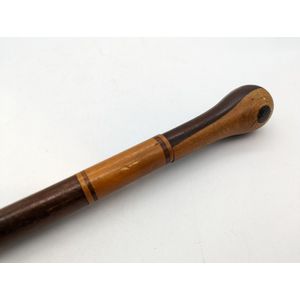
Vintage Inlaid Folk Art Walking Stick - 85cm
Fruitwood vintage walking stick, sectional inlaid folk Art walking stick, length 85 cm
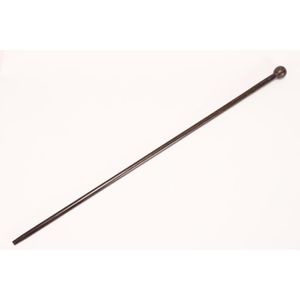
Ebony Walking Stick with Spherical Handle
Turned ebony walking stick, the shaft of tapering cylindrical form below a spherical handle, total length 88 cm
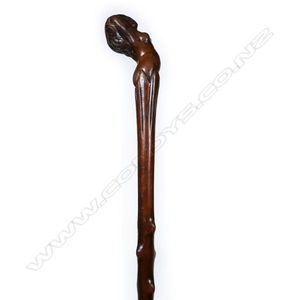
Carved wooden walking stick with naked maiden handle
A circa 1900 carved wooden handled walking stick, the handle as a naked maiden with arched back, length 79.5 cm.
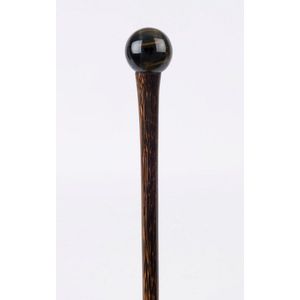
Tiger's Eye Walking Stick with Palmwood Shaft
A walking stick, spherical tiger's eye handle with palmwood shaft and metal ferrule, 94 cm high

Victorian Carved Prince of Wales Paddle Steamer Walking Stick
A Victorian carved 'Prince of Wales' paddle steamer walking stick, carved with images of the paddle steamer and with verse 'Well my friend, The sum of one shilling for you I gave, what compensation shall I have '....' Length 89 cm. Note: PS (RMS) Prince…

Telescope Walking Stick with Brass and Timber Handle
A timber and brass walking stick with telescope extension handle, length 94 cm

Timber and Brass Walking Stick with Telescope Handle
A timber and brass walking stick with Inbuilt telescope handle, length 99.5 cm
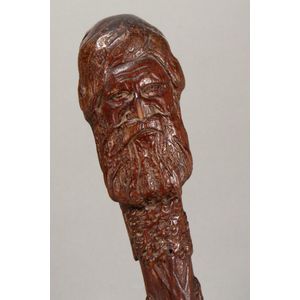
Australian Figural Walking Stick with Henry Parkes Handle
19th century Australian figural walking stick, the handle possibly carved with the head of Henry Parkes, above a tree flanked by kangaroo and emu, the shaft carved with coiled snake, total length 92 cm

Bent Wood Walking Stick Collection
A collection of bent wood walking sticks, including macassar ebony and birch, comprising fifteen pieces, the longest 100 cm
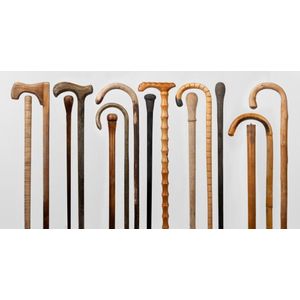
Carved Wood Walking Sticks and Canes (9 words)
A collection of carved wood walking sticks and canes, comprising fifteen pieces, the longest 97 cm
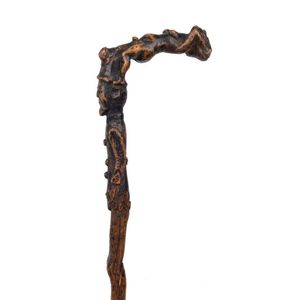
Carved Antique Walking Stick with Nude Figural Handle
An antique walking stick profusely carved from top to bottom, with nude figural handle, male figure, assorted symbols, flowers and inscription (partially legible) plus metal ferrule, 19th century, 85 cm high
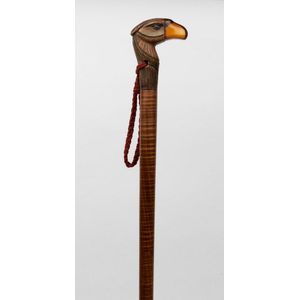
Carved Bird Head Walking Stick
A walking stick with carved wooden bird's head handle and resin beak, fiddleback shaft with brass ferrule, early 20th century, 90 cm high

19th Century Blackthorn Walking Stick with Dog's Head Handle
An antique walking stick, carved dog's head handle and shaft made from a single piece of blackthorn, 19th century, 84 cm high

19th Century Walking Stick Gun
A part 19th century Day's Patent walking stick gun, the mahogany handle with round steel section, signed enclosed action with under-hammer and folding trigger. Stock and barrel absent. Length 20 cm.

Serpent Carved Wood Club with Mother of Pearl Inlay
Tribal/Islander carved wood club/walking stick carved serpent and masks motif with mother of pearl inlay. Length 94 cm
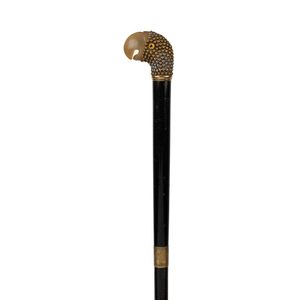
19th Century Parrot Head Walking Stick
An antique walking stick with parrot head handle, ebony shaft and later rubber ferrule, 19th century, 87 cm high
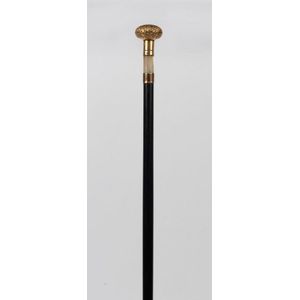
Gilt Handle Antique Walking Stick with Mother of Pearl Collar
An antique walking stick with gilt metal handle, mother of pearl collar, ebony shaft and brass ferrule, 19th century, 86 cm high

Vintage Walking Sticks and Parasols Collection
Collection of walking sticks and parasols, early 20th century and later, comprising a walking stick with shoe form handle, a natural burl walking stick, a walking stick/parasol and a parasol in French black silk with carved handle (4) approx., height 93…

Late 19th Century Fruitwood Walking Stick
Walking stick late 19th century, fruitwood with leather strap, length 84 cm
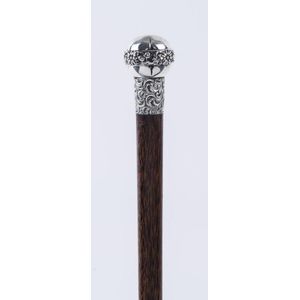
19th Century Sterling Handle Palmwood Walking Stick
An antique walking stick, palmwood shaft with sterling handle, 19th century, 81 cm high
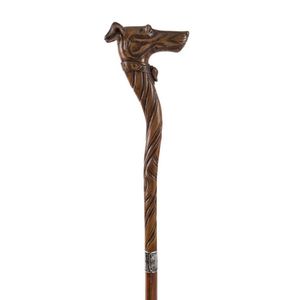
Victorian Dog Head Walking Stick with Articulated Mouth
An English novelty walking stick with carved box wood dog head handle with articulated mouth and glass eyes. These sticks where popular in the early Victorian era and the mouth was used to hold gloves, mid 19th century, 94 cm high

Carved Cedar Walking Stick with Serpent Fist, 19th Century
An Australian cedar walking stick, carved fist with entwined serpent, 19th century, 90 cm high

Carved Hand Walking Stick
A late 19th century hardwood carved clasped hand handled walking stick, the shaft top with ball and hand design, plain tapered shaft, length 96 cm.

Monkey Head Carved Walking Stick
Victorian carved wooden walking stick, the handle carved in the form of a monkey head, set with glass eyes above a natural stick, length 74 cm

Solomon Islands Ebony Walking Stick with Mother-of-Pearl Inlay
A vintage Solomon Islands ebony walking stick inlaid with cut mother-of-pearl (small losses), length 95 cm

Elephant Handle Camel Walking Stick
Oriental carved camel walking stick with elephant shape carving on the handle

Carved Wooden Walking Stick with Man's Head
Late 19th century wooden walking stick, carved with mans head, above cylindrical stick, length 84 cm

Gilt Horse Head Walking Stick - 88cm Length
Horse head timber and gilt mounted walking stick length 88 cm

Carved Fox Head Walking Stick with Glass Eyes
Antique carved fox head walking stick with glass eyes, length 72 cm.
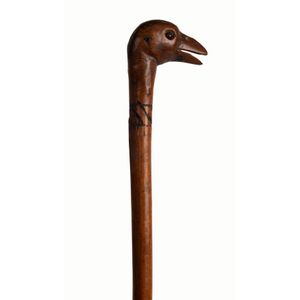
19th Century Carved Bird Head Walking Stick
A fruitwood walking stick with carved birds head handle, 19th century, 93 cm high

Australian Walking Stick with Kangaroo and Emu Carvings
An Australian walking stick carved with kangaroo and emu entwined within an intricate woven and spiral design, handle in the form of a boot, 19th century, 93 cm long

Mahogany Walking Stick with Enlistment Presentation Plaque
A sturdy turned mahogany walking stick, ebonised handle, an earlier presentation plaque attached detailing 'Presented to A. Henderson on his Enlisting for Active Service..... 15.2.18'.

Mahogany Walking Stick with Stag Antler Handle
A sturdy turned mahogany walking stick, stag antler section handle.

French bamboo shooting stick with hinged seat and steel spike
A circa 1880 French bamboo shooting stick, with hinged seat and steel spike and stamped (to metal) 'Br. SGDG' (French patent marks)

Briar Dog Head Walking Stick
A briar walking stick, the handle in the form of a dog's head, glass eyes with brass collar.

Phar Lap Walking Stick with Horse Hoof Handle
Tommy Woodcock, Phar Lap walking stick, fruitwood with horses hoof handle, carved 'Good luck Pharlap A.R.W.', carved monogram 'A.R.W.', 93 cm long
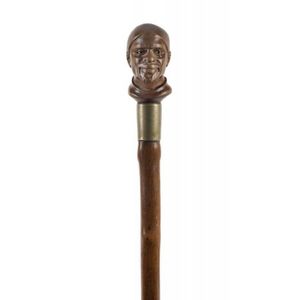
Nubian Head Walking Stick, 19th Century
A walking stick with carved nubian head handle, 19th century, 85 cm long

Snake Relief Walking Stick, Early 20th Century
A hand carved walking stick with snake relief, c. Early 20th century 90 cm

Carved Walking Stick with Tattooed Head and Paua Inset
Folk carved walking stick tattooed head handle with inset eyes and teeth, a shaft carved and inset with paua, length 86 cm

Concealed Umbrella Walking Stick with Burr Timber Shaft
A burr timber concealed umbrella walking stick, the hollow timber shaft in three sections, the curved handle with attached umbrella. Length 92 cm. Provenance: The Flower Family Collection.

Rewarewa Walking Stick with Greek Comedy Mask Handle
A rewarewa walking stick, the shaft terminating in a moulded ivorine handle decorated with theatre curtains and the Greek comedy masks, metal ferrule to the tip. Length 88 cm. Provenance: The Flower Family Collection.
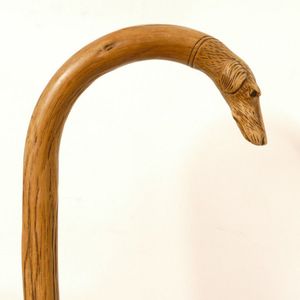
Hound-Tipped Hazelnut Hiking Stick
A hazelnut walking stick, the tip carved with the head of a hound, the end with metal hiking spike.

Timorese Walking Stick with Figurative Pommel and Lizard Frieze
Finely carved Timorese walking stick, in hardwood carved with a figurative pommel above a frieze of stylised lizards within concentric geometric bands, length 91 cm

Geometric New Zealand Wood Walking Stick
A vintage New Zealand walking stick, the handle in the form of various mixed New Zealand woods in a geometric pattern.
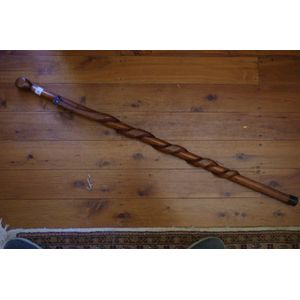
Serpent-Carved Antique Walking Stick with Blue Stone Eyes
Antique carved walking stick, with entwined serpent with blue stone eyes
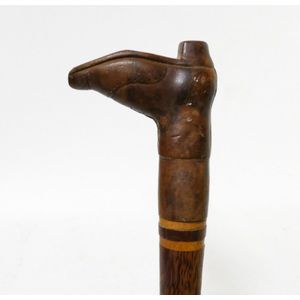
Boot-Handled Palmwood Walking Stick
A palmwood walking stick with handle carved as an upturned boot.

Briar Walking Stick with Dog Handle
A 19th century walking stick, the briar shaft with a dog carved to the handle.

Bamboo Walking Stick with Carved Dog's Head
An 19th century walking stick, the bamboo shaft with curved handle terminating in a carved wooden dogs head, the head with glass eyes.
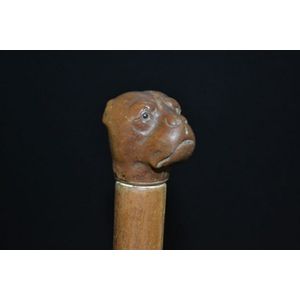
Timber Bulldog Walking Stick with Glass Eyes
Carved timber bulldog head handle walking stick with glass eyes
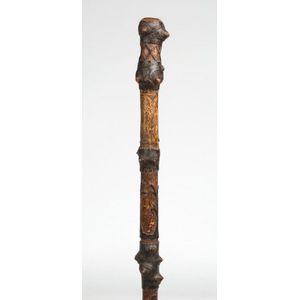
19th Century Irish Blackthorn Carved Walking Stick
An Irish blackthorn carved walking stick, 19th century, 95 cm
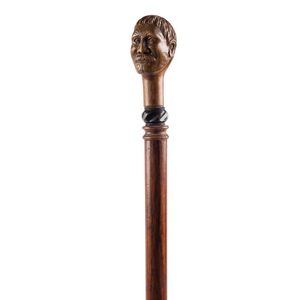
Late 19th Century Carved Hardwood Walking Stick from New Zealand
A carved hardwood walking stick, New Zealand timbers, late 19th century, 97 cm

Rare Ebony Gambling Walking Stick from England
A rare ebony walking stick with gambling handle. Purchased in England for '300. 92 cm long.
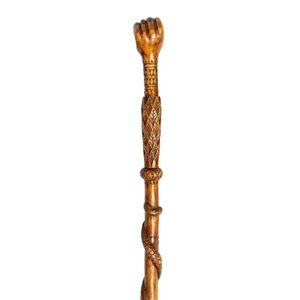
Aboriginal Mulga Walking Stick with Fist Handle and Snake
A mulga wood walking stick carved with a fist handle and snake, most likely Aboriginal, 86 cm

English 20 bore shotgun walking stick
An early 20th century English 20 bore shotgun walking stick, the cylindrical steel shaft wider at the top, original dark brown paint finish, swivelling bayonet release to receive the cartridge, exposed small trigger, sliding side button, the mahogany…

Irish Clover and Horse Leg Walking Sticks
Two walking sticks, one carved with Irish clovers (93 cm), on with a handle in the form of a horse's leg and hoof (87 cm).

Antler-handled walking stick with whistle, 19th century
An English country walking stick with deer antler handle and carved whistle, 19th century. 145 cm

Mahogany Walking Stick with Brass Mount
Victorian mahogany walking stick, carved with geometric and floral design, with brass mount. Height 87.5 cm

Crop and Stick: Victorian Era Accessories
Riding crop, 1883 and bamboo walking stick, approx 92 cm long and 65 cm long (2)

Antique Carved Rabbit Head Walking Stick
Antique timber carved rabbit head walking stick, Brass tip at bottom. 98 cm long
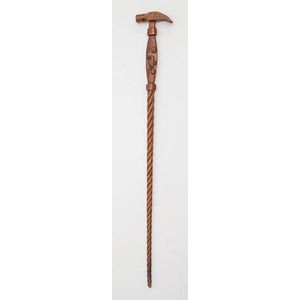
Fruitwood Carved Hunting Walking Stick from New Zealand
Early 19th century presentation walking stick fruitwood carved, hammer grip with carving of hunting scene and moa entitled 'New Zealand Lochum Westport', 87 cm length
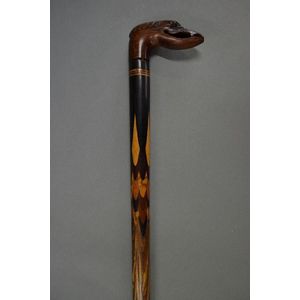
Duck Head Carved Walking Stick
Antique carved walking stick bearing the head of a duck with the stick decorated with a duck feather design, approx 88 cm long
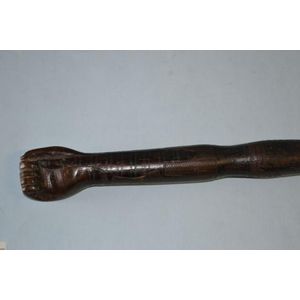
Indigenous Carved Walking Stick with Australian Wildlife Motifs
Carved Australian walking stick with Indigenous motifs, kangaroo, emu, snake, Lizards etc

Carved Oriental Walking Stick with Decorative Figure
Antique oriental walking stick, with carved figure and decoration to stick

Carved Ebony Walking Stick with Dog Face Handle
Antique heavy carved ebony walking stick, with dog face handle

Antique Rewarewa Walking Stick with Stag Antler Handle
An antique Rewarewa walking stick with Crown and stag antler handle, brass ferule cap. Length 98 cm
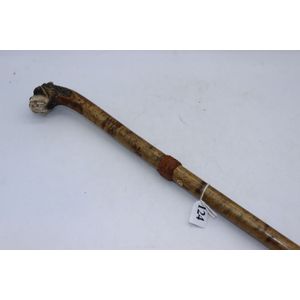

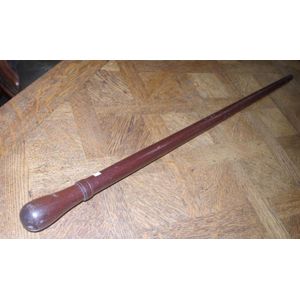



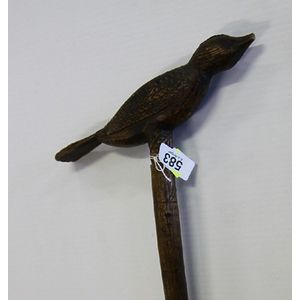
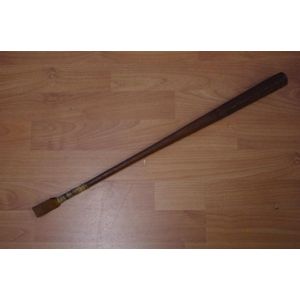
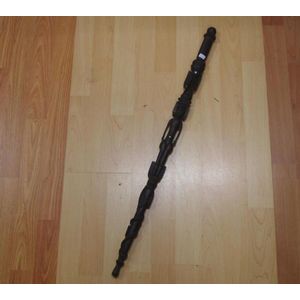

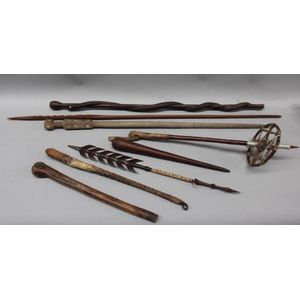










 Loading more...
Loading more...